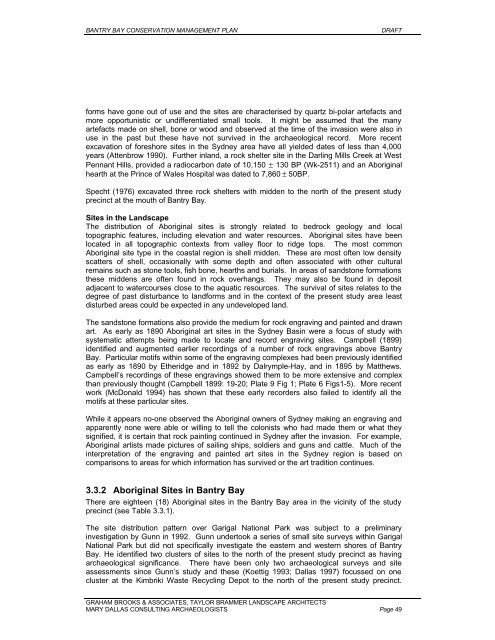Bantry Bay (Garigal National Park) - Department of Environment and ...
Bantry Bay (Garigal National Park) - Department of Environment and ...
Bantry Bay (Garigal National Park) - Department of Environment and ...
You also want an ePaper? Increase the reach of your titles
YUMPU automatically turns print PDFs into web optimized ePapers that Google loves.
BANTRY BAY CONSERVATION MANAGEMENT PLAN<br />
DRAFT<br />
forms have gone out <strong>of</strong> use <strong>and</strong> the sites are characterised by quartz bi-polar artefacts <strong>and</strong><br />
more opportunistic or undifferentiated small tools. It might be assumed that the many<br />
artefacts made on shell, bone or wood <strong>and</strong> observed at the time <strong>of</strong> the invasion were also in<br />
use in the past but these have not survived in the archaeological record. More recent<br />
excavation <strong>of</strong> foreshore sites in the Sydney area have all yielded dates <strong>of</strong> less than 4,000<br />
years (Attenbrow 1990). Further inl<strong>and</strong>, a rock shelter site in the Darling Mills Creek at West<br />
Pennant Hills, provided a radiocarbon date <strong>of</strong> 10,150 ± 130 BP (Wk-2511) <strong>and</strong> an Aboriginal<br />
hearth at the Prince <strong>of</strong> Wales Hospital was dated to 7,860 ± 50BP.<br />
Specht (1976) excavated three rock shelters with midden to the north <strong>of</strong> the present study<br />
precinct at the mouth <strong>of</strong> <strong>Bantry</strong> <strong>Bay</strong>.<br />
Sites in the L<strong>and</strong>scape<br />
The distribution <strong>of</strong> Aboriginal sites is strongly related to bedrock geology <strong>and</strong> local<br />
topographic features, including elevation <strong>and</strong> water resources. Aboriginal sites have been<br />
located in all topographic contexts from valley floor to ridge tops. The most common<br />
Aboriginal site type in the coastal region is shell midden. These are most <strong>of</strong>ten low density<br />
scatters <strong>of</strong> shell, occasionally with some depth <strong>and</strong> <strong>of</strong>ten associated with other cultural<br />
remains such as stone tools, fish bone, hearths <strong>and</strong> burials. In areas <strong>of</strong> s<strong>and</strong>stone formations<br />
these middens are <strong>of</strong>ten found in rock overhangs. They may also be found in deposit<br />
adjacent to watercourses close to the aquatic resources. The survival <strong>of</strong> sites relates to the<br />
degree <strong>of</strong> past disturbance to l<strong>and</strong>forms <strong>and</strong> in the context <strong>of</strong> the present study area least<br />
disturbed areas could be expected in any undeveloped l<strong>and</strong>.<br />
The s<strong>and</strong>stone formations also provide the medium for rock engraving <strong>and</strong> painted <strong>and</strong> drawn<br />
art. As early as 1890 Aboriginal art sites in the Sydney Basin were a focus <strong>of</strong> study with<br />
systematic attempts being made to locate <strong>and</strong> record engraving sites. Campbell (1899)<br />
identified <strong>and</strong> augmented earlier recordings <strong>of</strong> a number <strong>of</strong> rock engravings above <strong>Bantry</strong><br />
<strong>Bay</strong>. Particular motifs within some <strong>of</strong> the engraving complexes had been previously identified<br />
as early as 1890 by Etheridge <strong>and</strong> in 1892 by Dalrymple-Hay, <strong>and</strong> in 1895 by Matthews.<br />
Campbell’s recordings <strong>of</strong> these engravings showed them to be more extensive <strong>and</strong> complex<br />
than previously thought (Campbell 1899: 19-20; Plate 9 Fig 1; Plate 6 Figs1-5). More recent<br />
work (McDonald 1994) has shown that these early recorders also failed to identify all the<br />
motifs at these particular sites.<br />
While it appears no-one observed the Aboriginal owners <strong>of</strong> Sydney making an engraving <strong>and</strong><br />
apparently none were able or willing to tell the colonists who had made them or what they<br />
signified, it is certain that rock painting continued in Sydney after the invasion. For example,<br />
Aboriginal artists made pictures <strong>of</strong> sailing ships, soldiers <strong>and</strong> guns <strong>and</strong> cattle. Much <strong>of</strong> the<br />
interpretation <strong>of</strong> the engraving <strong>and</strong> painted art sites in the Sydney region is based on<br />
comparisons to areas for which information has survived or the art tradition continues.<br />
3.3.2 Aboriginal Sites in <strong>Bantry</strong> <strong>Bay</strong><br />
There are eighteen (18) Aboriginal sites in the <strong>Bantry</strong> <strong>Bay</strong> area in the vicinity <strong>of</strong> the study<br />
precinct (see Table 3.3.1).<br />
The site distribution pattern over <strong>Garigal</strong> <strong>National</strong> <strong>Park</strong> was subject to a preliminary<br />
investigation by Gunn in 1992. Gunn undertook a series <strong>of</strong> small site surveys within <strong>Garigal</strong><br />
<strong>National</strong> <strong>Park</strong> but did not specifically investigate the eastern <strong>and</strong> western shores <strong>of</strong> <strong>Bantry</strong><br />
<strong>Bay</strong>. He identified two clusters <strong>of</strong> sites to the north <strong>of</strong> the present study precinct as having<br />
archaeological significance. There have been only two archaeological surveys <strong>and</strong> site<br />
assessments since Gunn’s study <strong>and</strong> these (Koettig 1993; Dallas 1997) focussed on one<br />
cluster at the Kimbriki Waste Recycling Depot to the north <strong>of</strong> the present study precinct.<br />
GRAHAM BROOKS & ASSOCIATES, TAYLOR BRAMMER LANDSCAPE ARCHITECTS<br />
MARY DALLAS CONSULTING ARCHAEOLOGISTS Page 49
















